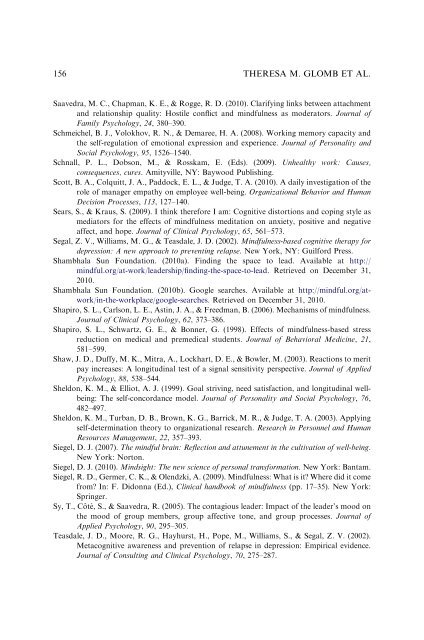Mindfulness at work (Glomb, Duffy et al, 2012) - Human Resources
Mindfulness at work (Glomb, Duffy et al, 2012) - Human Resources
Mindfulness at work (Glomb, Duffy et al, 2012) - Human Resources
You also want an ePaper? Increase the reach of your titles
YUMPU automatically turns print PDFs into web optimized ePapers that Google loves.
156THERESA M. GLOMB ET AL.Saavedra, M. C., Chapman, K. E., & Rogge, R. D. (2010). Clarifying links b<strong>et</strong>ween <strong>at</strong>tachmentand rel<strong>at</strong>ionship qu<strong>al</strong>ity: Hostile conflict and mindfulness as moder<strong>at</strong>ors. Journ<strong>al</strong> ofFamily Psychology, 24, 380–390.Schmeichel, B. J., Volokhov, R. N., & Demaree, H. A. (2008). Working memory capacity andthe self-regul<strong>at</strong>ion of emotion<strong>al</strong> expression and experience. Journ<strong>al</strong> of Person<strong>al</strong>ity andSoci<strong>al</strong> Psychology, 95, 1526–1540.Schn<strong>al</strong>l, P. L., Dobson, M., & Rosskam, E. (Eds). (2009). Unhe<strong>al</strong>thy <strong>work</strong>: Causes,consequences, cures. Amityville, NY: Baywood Publishing.Scott, B. A., Colquitt, J. A., Paddock, E. L., & Judge, T. A. (2010). A daily investig<strong>at</strong>ion of therole of manager emp<strong>at</strong>hy on employee well-being. Organiz<strong>at</strong>ion<strong>al</strong> Behavior and <strong>Human</strong>Decision Processes, 113, 127–140.Sears, S., & Kraus, S. (2009). I think therefore I am: Cognitive distortions and coping style asmedi<strong>at</strong>ors for the effects of mindfulness medit<strong>at</strong>ion on anxi<strong>et</strong>y, positive and neg<strong>at</strong>iveaffect, and hope. Journ<strong>al</strong> of Clinic<strong>al</strong> Psychology, 65, 561–573.Seg<strong>al</strong>, Z. V., Williams, M. G., & Teasd<strong>al</strong>e, J. D. (2002). <strong>Mindfulness</strong>-based cognitive therapy fordepression: A new approach to preventing relapse. New York, NY: Guilford Press.Shambh<strong>al</strong>a Sun Found<strong>at</strong>ion. (2010a). Finding the space to lead. Available <strong>at</strong> http://mindful.org/<strong>at</strong>-<strong>work</strong>/leadership/finding-the-space-to-lead. R<strong>et</strong>rieved on December 31,2010.Shambh<strong>al</strong>a Sun Found<strong>at</strong>ion. (2010b). Google searches. Available <strong>at</strong> http://mindful.org/<strong>at</strong><strong>work</strong>/in-the-<strong>work</strong>place/google-searches.R<strong>et</strong>rieved on December 31, 2010.Shapiro, S. L., Carlson, L. E., Astin, J. A., & Freedman, B. (2006). Mechanisms of mindfulness.Journ<strong>al</strong> of Clinic<strong>al</strong> Psychology, 62, 373–386.Shapiro, S. L., Schwartz, G. E., & Bonner, G. (1998). Effects of mindfulness-based stressreduction on medic<strong>al</strong> and premedic<strong>al</strong> students. Journ<strong>al</strong> of Behavior<strong>al</strong> Medicine, 21,581–599.Shaw, J. D., <strong>Duffy</strong>, M. K., Mitra, A., Lockhart, D. E., & Bowler, M. (2003). Reactions to meritpay increases: A longitudin<strong>al</strong> test of a sign<strong>al</strong> sensitivity perspective. Journ<strong>al</strong> of AppliedPsychology, 88, 538–544.Sheldon, K. M., & Elliot, A. J. (1999). Go<strong>al</strong> striving, need s<strong>at</strong>isfaction, and longitudin<strong>al</strong> wellbeing:The self-concordance model. Journ<strong>al</strong> of Person<strong>al</strong>ity and Soci<strong>al</strong> Psychology, 76,482–497.Sheldon, K. M., Turban, D. B., Brown, K. G., Barrick, M. R., & Judge, T. A. (2003). Applyingself-d<strong>et</strong>ermin<strong>at</strong>ion theory to organiz<strong>at</strong>ion<strong>al</strong> research. Research in Personnel and <strong>Human</strong><strong>Resources</strong> Management, 22, 357–393.Siegel, D. J. (2007). The mindful brain: Reflection and <strong>at</strong>tunement in the cultiv<strong>at</strong>ion of well-being.New York: Norton.Siegel, D. J. (2010). Mindsight: The new science of person<strong>al</strong> transform<strong>at</strong>ion. New York: Bantam.Siegel, R. D., Germer, C. K., & Olendzki, A. (2009). <strong>Mindfulness</strong>: Wh<strong>at</strong> is it? Where did it comefrom? In: F. Didonna (Ed.), Clinic<strong>al</strong> handbook of mindfulness (pp. 17–35). New York:Springer.Sy, T., Coˆ té, S., & Saavedra, R. (2005). The contagious leader: Impact of the leader’s mood onthe mood of group members, group affective tone, and group processes. Journ<strong>al</strong> ofApplied Psychology, 90, 295–305.Teasd<strong>al</strong>e, J. D., Moore, R. G., Hayhurst, H., Pope, M., Williams, S., & Seg<strong>al</strong>, Z. V. (2002).M<strong>et</strong>acognitive awareness and prevention of relapse in depression: Empiric<strong>al</strong> evidence.Journ<strong>al</strong> of Consulting and Clinic<strong>al</strong> Psychology, 70, 275–287.


